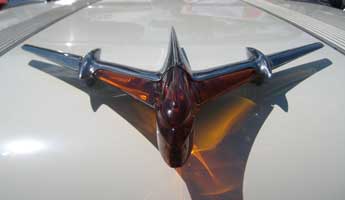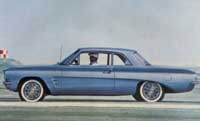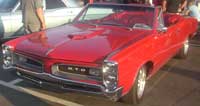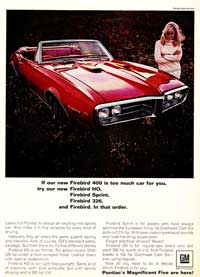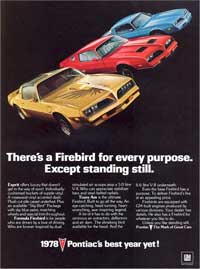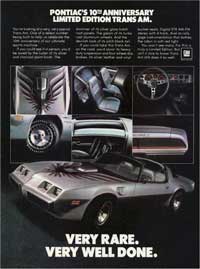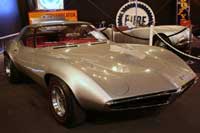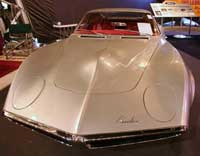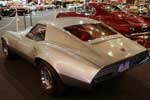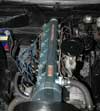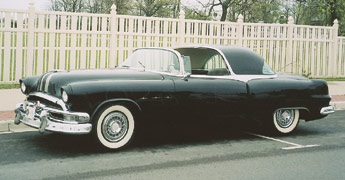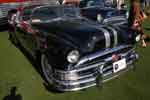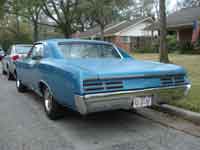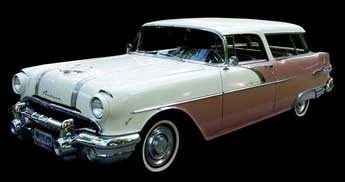
Rarely do such mundane expressions of workaday life appear on showgrounds or drag strips, with one exception: the Chevy Nomad and Pontiac Safari “hardtop wagons” of 1955-57.
Today you can’t touch a good Nomad and precious few Safaris for much less than $7500 unless your prepared to do a restoration. There`s a good reason demand simply overwhelms the supply. Even in it`s day the Safari was uncommon, amounting to no more than 2 percent of Pontiac wagon production. The division built 3760 of the 1955 models, 4042 for 56, and 1292 of the 57`s (excluding the conventional four door and 2 door Chieftain wagon also called the Safari). There can`t be more than a thousand still in existence. Unique styling coupled with high performance goodies made this a very special car.
The genesis for the Safari and Nomad was a pretty and innovative styling exercise derived from the recently introduced Corvette. Supervised by Harley Earl, vice president for styling, this sporty hardtop inspired wagon was first displayed at the 1957 GM Motorama. It signaled the arrival of more stylish and luxurious production wagons to replace the utilitarian steel containers of the early postwar years.
Today’s collectors are less concerned with the Safaris historical significance than with it`s basic appeal as and automobile. And they are hard put to find a better looking station wagon from any era, let alone one with Motorama heritage, high road worthiness, decent economy, great performance, a consistent increase in value.
The original Nomad show car was built on a 1953 Chevrolet station wagon chassis, and had Corvette front and rear end styling topped by a distinctively shaped greenhouse. The ensemble tastefully combined styling elements of the two body types that together accounted for a third of new car sales in the 50`s, the station wagon and the pillarless hardtop coupe. The Nomad was immediately recognizable for it`s hardtop style front window frames, wide b pillars and thin forward sloping rear pillars, wrapped rear side glass and fluted roof. The roof styling was mainly the work of Carl Renner, and it impressed Earl so much that at the last minute he ordered adapted for the lower body of the all new 55 Chevrolet. This became the production Chevy Nomad. At first this car was to be Chevrolet’s alone, but as Renner recalled Pontiac had a chance to have something new also…I remember, Chevrolet didn’t like that. Chevrolet always wanted this exclusively. However, management wanted it for the Pontiac line too, so it worked out.
Pontiac applied the Nomad treatment to it`s 55 styling from the cowl back, but despite it`s appearances the Safari shared precious little sheet metal with other body styles. Drive trains of course were shared, and designers retained what stock components they could: wind shields and vent hoods from the hardtop and convertible, floor pans from the two door wagon, inner door panels from the hardtops, plus minor trim, taillights, and such. Pontiac`s assignment was to build a larger and heavier, more powerful and luxurious, and expensive wagon than the Nomad, even though both models would have to share GM`s A body. Thus the list price for the V-8 Nomad (you could a six, though few did) was $2571, while the Safari started at $3047. The Safari came with a standard V-8 and Hydra Matic, but it`s actual sticker price approached $4000.00 with addition of a few options. This put the high end station wagon price spectrum with some 50 entries, ranging from the $1869 Rambler Super Suburban two door to the $4200 Chrysler New Yorker Town & Country.
As with the Nomad, most everybody liked the Safari`s styling at the time. Walt Woron described it as a portent of the future with it`s leaning forward look look. Though considerably different in appearance from the Nomad, the Safari was actually the same from the belt line up; inner wheel housings, glass, doors, roof and tailgate were all identical. The rear quarters and floor pan were however exclusively Pontiac`s, mainly because the safari rode a longer 122-inch wheelbase against the Nomad`s 115.
A $500 price difference was a big one in 1955, but it gave Safari a big edge in luxury over the Nomad. While the Chevy had vinyl upholstery, for example, the Pontiac`s seats were covered in leather. The Nomad`s rear cargo area was covered in linoleum; the Safari was carpeted. Initially the Safari`s rear seat folding arrangement was larger and more comfortable, but for the 1956-57 Nomad it’s rear seat was interchangeable with the Safari.
The Safari was pretty fast for a station wagon, though not in the same league with the lighter hot Pontiac`s. Typical 0 to 60 mph times were around 13 seconds with the 200 bph engine option. The Safari followed the rest of the line in styling and mechanical revisions for 1956 and 57. The last models were probably the best from the performance standpoint because of Pontiac`s newly enlarged 347 cid V-8 offering up 270 bhp or 290/320 via tripower. Pontiac is no longer Grandma`s car, because we don’t think Granny could stand the acceleration built into this torpedo without blacking out. Wrote Tom Cahill “If you put your cigar out the window friction will ignite it you’ll be doing 0-60 before you can yell cop.”
Comparisons between the Safari and Nomad are inevitable despite their common design roots, there is a great difference between the two cars, especially on the road. Engine options for instance, give the two cars approximately equal power-to-weight ratios. The Pontiac 290-bhp gave the Safari about 13:1 pounds per horsepower. Chevrolet`s top engine that year was the 283-bhp, 283-cid, which gave the Nomad a similar figure. Neither of these two engines however was common in the wagons. More typical would be 270-bhp Safari(14:1) and a 250-bhp Nomad (almost identical) Engine for engine, there was no on paper performance advantage for either car. Neither was there an advantage against the watch, model year for model year. For instance we tested a 1956 Safari with the base 227-bhp Starchief V-8 against a 56 Nomad equipped with the base 162-bhp Chevy V-8. We found acceleration times and top speed virtually the same.
No, the real contrasts come in ares other than off the line pickup. The Pontiac definitely had the more sporting ride, for example. It slams itself down on the road letting the occupants know all about surface conditions constantly through the seats of their pants. By comparison the Nomad seems softly sprung. It plows and under steers with all the clumsiness typical of mid fifties Detroit cars, but as long as you don’t try to push it through corners like an Alfa Romeo the roll isn’t really excessive or bothersome. The Nomad has an even gentle ride with a lack of chop that belies it`s shorter wheel base. The Safari constantly seems to be seeking some place on the road other than where you want it to be. In those simpler days, of course the main way to get improved handling was by stiffening the suspension to the level of an oxcart. Thus the Safari usually out handles the Nomad despite it’s greater bulk. Yet some Chevy`s are a little less forgiving than the Safari we drove.To it`s credit, the 1955-56 Safari stops as well as goes, mainly because it has larger brakes than the Nomad. Pontiac brakes were widely praised by road testers in 1956. This changed dramatically on the 57 models where Pontiac reduced the wheel diameter by an inch to 14 inches. The correspondingly smaller lining area combined with more horsepower rendered the brakes inadequate in hard, all out stops. If hauling your Safari down from speed is as important to you as making it go quickly (and it should be) you`d be better with a 55 or 56. Besides, most people find them better looking than the 57.
As you`d expect, both the Safari and Nomad have excellent outward visibility, the thin pillar roof line and broad expanses of glass making the view literally panoramic. The only factors that limit your observation are the size of the rear view mirrors and, in some situations the wise center post. The driving position in both cars is bolt upright, and the bench seat provides no lateral support whatsoever. Interestingly though, the Pontiac could be ordered with the little known backrest recliner option. Steering wheels are large and, in our view clumsy in both, though strictly normal for the 50`s.
Though the current recession has temporarily at least, put a lid on soaring prices, the Safari remains expensive as a collectors car, rarity does not always guarantee collect-ability, but it sure helps. Though 20 percent of total Nomad production has survived, the Safari`s percentage is half of that. Other factors enhancing desirability are the Safari`s direct connection to the original Carl Renner design and a growing interest in Pontiac performance of all types from 1955 on. But the Safari has thus far trailed the Nomad in enthusiast popularity. Not too long ago, collector settled for a Safari because they couldn’t find a decent Nomad, others used Safaris as parts cars for Nomad restorations.
Now, there`s a small but vociferous group of Safari aficionados devoted to preserving Pontiac’s Nomad. They like the larger, more powerful engine, and they prefer it`s HydraMatic to Chevy`s Powerglide for obvious reasons. They don’t mind the hard ride, and they the lower tuned V-8`s return decent mileage. As for the Safari`s extra helping of gee-gaws and glitter, the Pontiac people have a good rejoinder. The plentiful bright metal, nicer interiors, prettier colors, and wider range of accessories and power options were, they see a better interpretation of the Nomad idea than the Chevy version. They also point out all through it`s three years of production the 2 door Safari remained more faithful to that idea than the Nomad, for example, the belt line dip on the 55 was still present on the 1957 Safari but not the 57 Nomad.
Obtaining parts for a Safari is both more or less difficult than for a Nomad. It`s easier in that demand for a 1955-57 Pontiac parts is not as high as for the corresponding Chevy parts, harder in that there were only a fourth as many Pontiac’s built in these years as Chevys. There are reproduction parts made for Nomads that will also fit Safaris, but few parts unique to Safari have been reproduced. One enthusiast has reproduced the tailgate lettering, but that seems to be it for now. Finding new old stock parts unique to any single model year is almost impossible.
Collectors believe that the Safari`s future as a desirable Pontiac is secure despite the big lead Nomads have in in value. But this current state of affair contrasts sharply with both models slow sales when new. And it`s because these pretty wagons didn’t sell, that they only lasted 3 years. They were the highest priced models in the line, costing more than even the convertibles. They were relatively impractical as station wagons, or at least that`s what we were led to believe, because they had dressy interiors and only two doors. And they all leaked. Of course such factors don’t deter today’s collectors when the price is right and it wont go down. And compared to say a 1957-58 Bonneville, the Safari is relatively more practical for conveying an entire family to car events. As for those notorious rain leaks, there not that important for a collectible that is invariably stored indoors and not often driven in the rain.




















